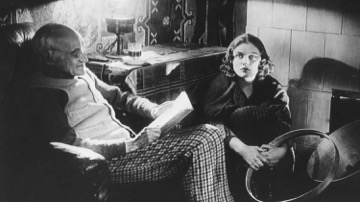“The Girl with the Hatbox (Devushka s korobkoi)” Interiors (1927)
Artist/Designer: Boris Barnet, Sergei Kozlovskii, Vadim Shershenevich, Valentin Turkin, Mezhrabpom-Russ
Project Location: Moscow, Russia

Style/Period(s):
No Style/Period Assigned.
Primary Material(s):
Glass, Fabric, Textile, Wood, Wall Paper, Paper, Light
Function(s):
Residential Structure, Entertainment, Film/TV Set
Related Website(s):
Significant Date(s):
20th Century, 1920, 1927
Additional Information:
Publications/Texts in Print:
Kirkham, Pat, Sarah A. Lichtman, and Eleanor Rees. “Comfort and the Domestic Interior in Soviet Fiction Cinema of the 1920s.” Essay. In Screen Interiors: From Country Houses to Cosmic Heterotopias, 36–40. London: Bloomsbury Visual Arts, 2021.
Attwood, "The New Economic Policy," 47.
Devushka s korobkoi (The Girl with a Hatbox) papers, 1.2.1.288. Screenplay for film (1927), 13-42, Gosfil' mofond State Film Archive of the Russian Federation, Belye stolby, Moscow, Russia.
Devushka s korobkoi (The Girl with a Hatbox) papers, 1.2.1.288. Screenplay for film (1927), 92, Gosfil' mofond State Film Archive of the Russian Federation, Belye stolby, Moscow, Russia.
Emma Widdis, "Cinema and the Art of Being: Towards a History of Early Soviet Set Design," in Birgit Beumers (ed.), A Companion to Russian Cinema, 315 (London: Wiley-Blackwell, 2016).
Sergei Kozlovskii, "Prava i obiazannosti kino-khudozhnika" ["The Rights and Responsibilities of the Set Designer"], Kino-zhurnal ARK [Cinema Journal ARK] 11-12 (1925): 16-17; Sergei Kozlovskii, "Tekhnika kinoatel'e" ["Film Studio Technology"], Kino i kul'tura [Cinema and Culture] 5 (1925):57-9.
Nikolai Kolin and Sergei Kozlovskii, "Khudozhnik-arkhitektor v kino" ["The Artist-Architect in Cinema"] (1930), reprinted in Kinovedcheskie zapiski [Film Scholars' Notes] 99 (2009): 389-92.
Osip Brik, "Fiksatsiia fakta" ["The Fixtion of the Fact"], Novyi lef [New Lef] 11-12 (1927): 44-50.
Aleksandr Rodchenko, "Khudozhnik i material' naia sreda v igrovom fil'me" ["The Artist and the Material Environment in Fiction Film"], Sovetskoe kino [Soviet Cinema] 5-6 (1927): 14.
Alina Payne, From Ornament to Object: Genealogies of Architectural Modernism (New Haven, CT: Yale University Press, 2012), 197.
Payne, From Ornament to Object, 243, 257.
Svetlana Boym, Common Places: Mythologies of Everyday Life in Russia (Cambridge, MA: Harvard University Press, 1994), 35.
Buchli, Archaeology of Socialism, 44.
For Example, see Benjamin's notion of "destructive dwelling," in Theodor Adorno and Walter Benjamin, The Complete Correspondence, 1928-1940, ed. Henri Lonitz, trans. Nicholas Walker (Cambridge: Polity Press, 1999), 104.
Emma Widdis, Socialist Senses: Film, Feeling and the Soviet Subject, 1917-1940 (Bloomington: Indiana University Press), 108-10.
Widdis, "Cinema and the Art of Being," 235
Widdis, "Cinema and the Art of Being," 238
Boris Arvatov,"Byt i kul'tura veshchi" ["Everyday Life and the Culture of the Thing"] (1925), trans. Christina Kiaer, October 81 (Summer 1997): 123.
Boris Arvatov,"Byt i kul'tura veshchi," 125.
Boris Arvatov,"Byt i kul'tura veshchi," 126.
Boris Arvatov,"Byt i kul'tura veshchi," 127.
Boym, Common Places, 64.
Buchli, Archaeology of Socialism, 56-7.
Viktor Shklovskii, "Pogranichnaia liniia,"[1927], reprinted in Viktor Shklovskii, Za 60 let. Raboty o kino [Through 60 years. Works on Cinema] (Moscow: Iskusstvo, 1985), 110-13.
Devushka s korobkoi (The Girl with a Hatbox) papers, 1.2.1.288. Screenplay for film (1927), 13-14, Gosfil'mofond State Film Archive of the Russian Federation, Belye stolby, Moscow, Russia.
Arvatov,"Byt i kul'tura veshchi," 119-28.
Building Address: Moscow, Russia.
Significant Dates: Released on April 19, 1928
Supporting Staff/ Designers:Boris Barnet (director), Sergei Kozlovskii (set designer), Vadim Shershenevich (poet), Valentin Turkin (screenwriter).
Tags: Soviet cinema, contemporary Moscow, silent film, Soviet fiction film, aesthetic economy, NEP era, Cultural Revolution, material culture, logging right issues, Soviet "everyday style".
Viewers should treat all images as copyrighted and refer to each image's links for copyright information.